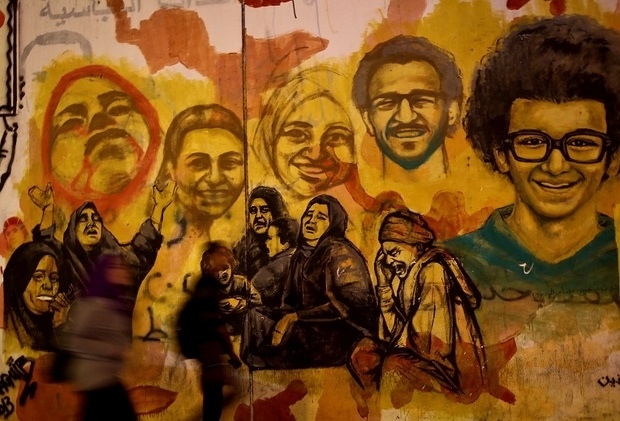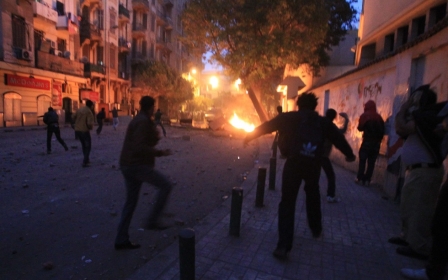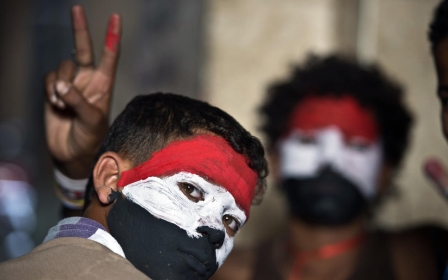Mohamed Mahmoud Street: A battle to keep the memory alive

"It really saddens me," says Zenobia, a blogger and activist. "For the artistic work but also for its political impact, as this place is a record of an important moment of the revolution, all the more so as it's one of the only places where you can still find graffiti condemning the army. That being said, this demolition will not change history or the fact that so much blood was spilled in this street."
In November 2011, the demonstrators were ambushed by the security forces in this small road leading to Tahrir Square. More than 50 people were killed on the cobblestones.
Last Friday, in the early morning, mechanical diggers and workers wearing yellow helmets began destroying pomegranate-coloured calligraphy and subsequently used their sledgehammers on the smiling portrait of a revolutionary.
"Now that they've demolished part of this street, you can literally walk to Tahrir and imagine that nothing happened here. How beneficial to the authorities," adds a young Egyptian woman interviewed by Middle East Eye with some irony.
A fight to keep the memory alive
For some years now Mohamed Mahmoud Street has attracted more than its fair share of attention. As the subject of numerous documentaries but also placed in the spotlight thanks to a book of photographs (Walls of Freedom) published last year and partially censored in Egypt, the street is one of the rare locations to have succeeded, at whatever cost, in displaying the wounds of the revolution in a Cairo undergoing rapid change.
As since he came to power, President Abdel Fattah al-Sisi has made a point of attenuating any outward signs of a revolt which he is seeking to suppress.
Over the last four years, Ammar, Abdo, Ganzeer, Mohamed and the other "paintbrush activists" have frequently returned with their cans of paint and their stencils despite the threats and despite the white paint spread over their previous work, to tell the story of the death of hundreds of Egyptians desperate for justice, and to condemn the brutal army and the oppression suffered by the Muslim Brotherhood.
'A non-political demolition'
For their part, the authorities deny attacking this symbol for being a symbol. They explain that this is a purely technical demolition operation.
"The demolition of this wall is being carried out in relation to the renovation of Cairo's American University located in Tahrir Square," explains Khaled Mustapha, a spokesman for the governor of Cairo. "We are only demolishing a part of the wall to allow the construction work to go ahead. This is in no way connected with politics or with the wall paintings in particular."
Brian McDougall, vice president of the university administration, says the demolition was necessary for the school's expansion.
"The university has decided that the science building, where the laboratories were based, was superfluous to requirements since our new campus opened [in Heliopolis]. As this building could not be used for other activities, we felt that the best thing would be to demolish it, to free up more green space."
"Demolishing the building required the creation of an access point to allow the machines in."
However, what the authorities have not fully explained is that the entire wall will be gradually demolished.
"The whole wall will be removed," continues McDougall. "It has to be, because we want an enclosure matching the new spirit of this campus, which is more focused on culture ... We must also recognise that what was featured on the wall more recently was not as important as that which was displayed there last year or the year before," he added, placing the symbolic impact of this demolition in perspective.
"But we are being very careful, as we wish to keep the memory alive, and for this reason we have photographed the wall before demolishing it," he assured us.
"The artistic heritage and traces of the revolution are not to be found only on this wall. There are many others, not only in Cairo but throughout the country, in Alexandria, Luxor or Aswan," added Khaled Mustapha, stressing that they have received no complaints from locals.
Angry revolutionaries
"I think this is a big issue for the revolutionary youth but the rest of the Egyptian population have so many worries with their gas bills or paying for their children's education that they are rather unconcerned about a few wall paintings," admits a forlorn Zenobia.
"In my view, the population's reaction is 50-50," says Mohamed Khaled, a graffiti artist who was involved in the artistic conquest of Mohamed Mahmoud Street. "Many people are generally unhappy with this renovation process in Cairo and the fact that Tahrir Square is unrecognisable, et cetera, but many are also happy as they need hope once again, and that requires nicer and clean surroundings."
"Not everyone here is rebelling all the time," says Farid Gharal, a resident of Cairo irritated by all the fuss generated by the demolition of this wall.
"These plans by the university are perhaps genuine, but they are also linked to the wall paintings," says Ahmed Hassan, a revolutionary activist and the main character from the documentary "The Square" dealing with the revolution of 2011.
"This is a battle which has been waged for years. The street is systematically reconquered by the artists every time the paintings are removed," he explains to MEE. "People are saying that it's shameful. Whether it is or it isn't, whatever happens we won't give up, and new paintings will appear."
Khaled adds: "In itself, the destruction of a wall to replace it with a new fence should not be a problem. But it is in this case, as this is one of the last remaining traces of the revolution and one which is very precious in the view of many people."
'In any case, how could we forget'
"No one and nothing can destroy the spirit of the revolution! New paintings will appear! Long live Tahrir!" writes the street artist Pit Becker on his Twitter account. It is mainly on social networks that those in favour of the revolution have expressed their disappointment, in the absence of any possibility to take to the streets due to repression by the authorities.
A meme has quickly made its appearance on the web showing the Egyptian president putting his head behind the partially demolished wall, effectively mocking his responsibility in the destruction of this symbolic site.
On a more serious note, Sally, a well-known activist, published this quotation by W. James Booth on her Facebook page:
"The historical past, a terrain mapped along a grid of a causally linked series of events, across linear, homogenous time, does individuate us, as persons and communities, but it is memory, individual or collective, whose landscape is uneven, marked by trauma, conflict and guilt, and is always eliding the past and present, that by gathering in this past, by appropriating it, it gives us identity and a moral narrative of pride, shame and indebtedness that ties us across time to our past and the burdens this past imposes simply by virtue of being ours."
This is Sally's depersonalised comment to express her weariness, given the constant attacks on the memory of the revolution over the last four and a half years.
"Demolishing the wall or the paintings will not erase the memory of Mohamed Mahmoud," says Rahmy Abdallah, a young Egyptian Twitter user. "In any case, how could we forget?"
New MEE newsletter: Jerusalem Dispatch
Sign up to get the latest insights and analysis on Israel-Palestine, alongside Turkey Unpacked and other MEE newsletters
Middle East Eye delivers independent and unrivalled coverage and analysis of the Middle East, North Africa and beyond. To learn more about republishing this content and the associated fees, please fill out this form. More about MEE can be found here.




